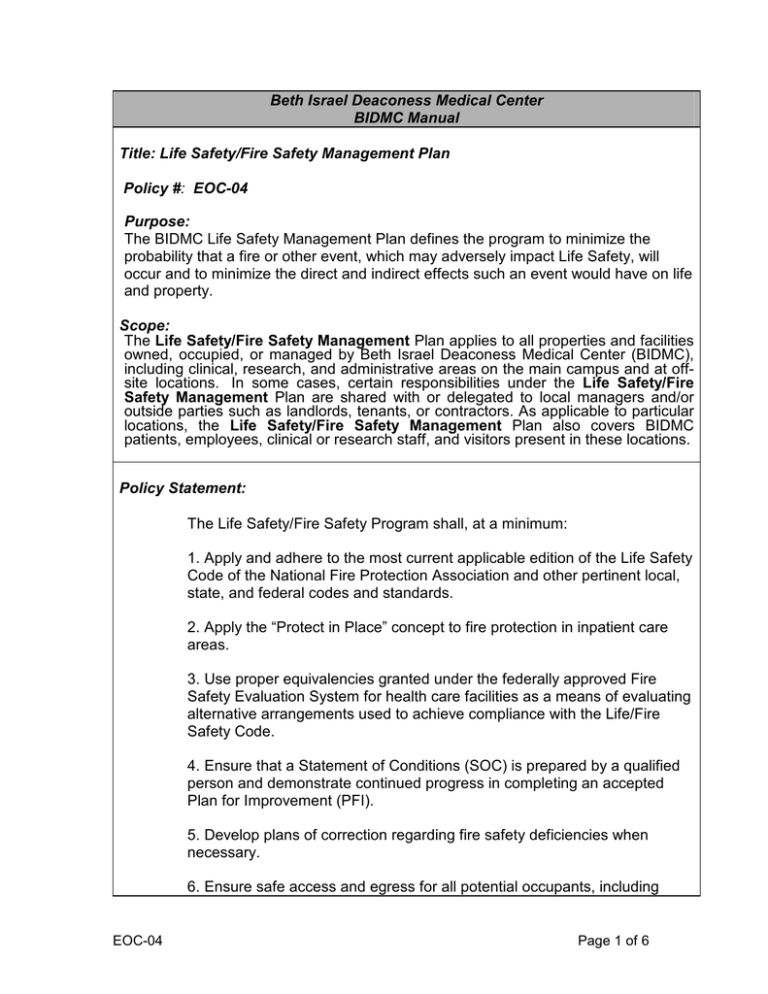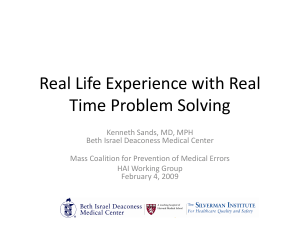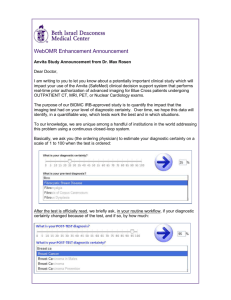Life Safety/Fire Safety Management Plan Policy #: EOC
advertisement

Beth Israel Deaconess Medical Center BIDMC Manual Title: Life Safety/Fire Safety Management Plan Policy #: EOC-04 Purpose: The BIDMC Life Safety Management Plan defines the program to minimize the probability that a fire or other event, which may adversely impact Life Safety, will occur and to minimize the direct and indirect effects such an event would have on life and property. Scope: The Life Safety/Fire Safety Management Plan applies to all properties and facilities owned, occupied, or managed by Beth Israel Deaconess Medical Center (BIDMC), including clinical, research, and administrative areas on the main campus and at offsite locations. In some cases, certain responsibilities under the Life Safety/Fire Safety Management Plan are shared with or delegated to local managers and/or outside parties such as landlords, tenants, or contractors. As applicable to particular locations, the Life Safety/Fire Safety Management Plan also covers BIDMC patients, employees, clinical or research staff, and visitors present in these locations. Policy Statement: The Life Safety/Fire Safety Program shall, at a minimum: 1. Apply and adhere to the most current applicable edition of the Life Safety Code of the National Fire Protection Association and other pertinent local, state, and federal codes and standards. 2. Apply the “Protect in Place” concept to fire protection in inpatient care areas. 3. Use proper equivalencies granted under the federally approved Fire Safety Evaluation System for health care facilities as a means of evaluating alternative arrangements used to achieve compliance with the Life/Fire Safety Code. 4. Ensure that a Statement of Conditions (SOC) is prepared by a qualified person and demonstrate continued progress in completing an accepted Plan for Improvement (PFI). 5. Develop plans of correction regarding fire safety deficiencies when necessary. 6. Ensure safe access and egress for all potential occupants, including EOC-04 Page 1 of 6 those who are physically disabled. 7. Maintain Life Safety/Fire Safety during all levels of construction. 8. Ensure grounds safety. 9. Test detection, notification, and suppression systems to assure continual functionality. 10. Train and educate staff with regard to Life Safety/Fire Safety measures. Responsibilities A. Administration The administration of BIDMC accepts responsibility for the Life Safety/Fire Safety program’s leadership, effectiveness, and continuous review and improvement. The administration grants authority for managing all aspects of the Life Safety/Fire Safety Management plan to the collective efforts of the Director of Engineering and Infrastructure, Director of Maintenance Operations, the Director of Environmental Health & Safety, and the Director of Facilities Planning, Compliance & Construction (or their equivalents). B. Director of Maintenance Operations (or equivalent) The Director of Maintenance Operations, or equivalent, is responsible for coordinating all aspects of life and fire safety equipment maintenance including, but not limited to, fire detection, fire alarm, fire suppression, extinguishers, and all other equipment relating to the overall life safety program. The Director of Maintenance Operations shall ensure that all inspection, testing and maintenance of life safety and fire safety equipment is completed and documented according to regulatory guidelines and JC requirements. The Director of Maintenance Operations shall lead the investigation of fire events and fire alarm and suppression incidents caused by infrastructure and/or building equipment failure or malfunction with the assistance of the Director of Environmental Health & Safety. C. Director of Environmental Health & Safety (or equivalent) The Director of Environmental Health & Safety, or equivalent, has the responsibility for coordinating and documenting an effective fire drill program in accordance with regulatory guidelines, and for ensuring an effective staff fire safety education program. The Director of Environmental Health & Safety, in coordination with other key departments, will take the lead in investigating fire events, life safety deficiencies, other life safety events caused by human error, and the review of staff/equipment life safety EOC-04 Page 2 of 6 responses to such events. D. Director of Facilities Planning, Compliance & Construction (P,C, &C or equivalent) The Director of Facilities Planning, Compliance and Construction, or equivalent, is responsible for assuring life safety components are maintained during construction and renovation activities, by coordinating activities with appropriate BIDMC and contractor personnel. He/She must also ensure that pre-construction (PCRA) and infection control risk assessments (ICRA) are completed prior to construction. The Director of P, C, & C is also responsible for assuring all construction materials and new furnishings supplied during renovation activities comply with applicable fire standards. E. Director of Engineering and Infrastructure (or equivalent) The Director of Engineering and Infrastructure, or equivalent, is responsible for assuring life safety components are maintained during infrastructure construction activities, by coordinating activities with appropriate BIDMC and contractor personnel. Director must also ensure that pre-construction (PCRA) and infection control risk assessments (ICRA) are completed prior to infrastructure construction. The Director of Infrastructure is responsible for assuring all infrastructure construction activities comply with applicable fire standards. The Director of Infrastructure, in collaboration with the Directors of Maintenance Operations and Environmental Health and Safety (EH&S) shall be responsible for regulatory compliance with Federal, State, and local codes and ordinances as they apply to Life Safety systems. F. Department Heads / Managers The department heads/managers are responsible for Life Safety/Fire Safety within their departments. They set the example and inspire a focus in those they supervise by assuring that Life Safety/Fire Safety policies and procedures are understood and carried out and to ensure that no equipment or furniture is placed in the medical center that has not been reviewed and approved by the appropriate facilities or engineering departments with regard to compliance with applicable fire standards. G. Employees Employees are responsible for cooperating with all aspects of the Life Safety/Fire Safety Program and maintaining a competent level of understanding of their roles and responsibilities within the plan. They are also required to complete annual mandatory education programs and have a firm understanding of Life Safety/Fire Safety as specifically applied in the EOC-04 Page 3 of 6 departments in which they work. Employees shall not bring any furniture or equipment into the medical center that has not been approved by the appropriate facility or engineering departments with regard to applicable fire standards. Procedures and Monitoring A. The Life Safety/Fire Safety Management Program shall consist of policies and procedures directed to fire prevention and the protection of patients, staff, visitors, and property. At a minimum, the program shall address: 1. Assurance of Life Safety/Fire Safety for all building occupants during everyday occupancy and all stages of construction and renovation. 2. All construction projects are evaluated to determine whether Interim Life Safety Management (ILSM) applies. When necessary, ILSM will be implemented per BIDMC policy. 3. Reporting and investigating Life Safety/Fire Safety deficiencies. 4. Inspecting and testing of fire protection systems, equipment and components. 5. Training, especially the “Protect in Place”” approaches to Life Safety/Fire Safety. 6. Compliance with applicable fire standards for furnishings and decorations. B. Construction and Renovation 1. When planning demolition, construction, or renovation, BIDMC conducts a proactive risk assessment using risk criteria to identify hazards that could potentially compromise care, treatment, and services in occupied areas of the hospital’s buildings. 2. The control measures implemented during construction activities to reduce risk and minimize impact to occupied areas consider air quality requirements, infection control, utility requirements, noise, vibration, and emergency procedures and they are monitored for compliance. 3. The assessments are conducted in conjunction with Environmental Health and Safety, Infection Control, Maintenance, Facilities Planning, Design & Construction, Nursing and others as required. C. Program Indicators 1. The “Protect in Place” approach for life safety/fire safety must be EOC-04 Page 4 of 6 adhered to in inpatient areas because the rapid evacuation of bedridden patients is impractical. Therefore, all Life Safety/Fire Safety Systems must be maintained and tested as defined by applicable local, state and federal codes and standards. Staff, patients, and visitors will initially remain in areas (fire or smoke compartments separated from the site of origin) unaffected by fire or smoke. If needed, evacuation of affected areas would first be horizontally to an adjacent, unaffected fire or smoke compartment. Vertical evacuation, including to the exterior, is the final stage and Fire Safety/ Life Safety should be managed with the objective of avoiding this impractical movement. Staff, patients, and visitors in outpatient and administrative areas will respond according to building notification announcements. Refer to EC-36 Fire Response "Code Red" Policy for specific information. 2. Fire protection systems and equipment are inspected and tested according to TJC and NFPA requirements. 3. New furnishings, fabrics, carpets and similar items are not put into use unless the medical center has received manufacturers’ specifications on flame/smoke spread and said materials comply with local, state, federal and facility standards. 4. General Life Safety/Fire Safety training takes place initially during medical center orientation of new employees. Thereafter, departmentspecific training is provided by EH&S during fire drills, hazard surveillance rounds, and within individual departments upon department orientation with refresher training provided annually thereafter. Additional training is provided by EH&S if deficiencies noted during drills and/or actual events. Construction contractors are oriented through the Department of Facilities Planning, Design and Construction. 5. Fire drills are held at the rate of one per shift per quarter per building in all patient care areas and annually in business occupancies. At least 50% of drills are unannounced and all are critiqued to identify areas for improvement. 6. The effectiveness of fire response training is evaluated annually. D. Thresholds for Evaluation All aspects of the Life Safety/Fire Safety management identified in section A will have compliance requirements of 100%. Anything less will require immediate and or continuous evaluation and follow up. E. Review and Documentation EOC-04 Page 5 of 6 All tests, drills, problems, and reviews will be documented. The Fire and Life Safety Team meets regularly to review current trends in the areas of code red events, fire drills, ILSM, and Fire/Life Safety systems. The goal of this team is to correct negative trends through increased communication and knowledge sharing between the departments responsible for the management of Fire and Life Safety. This team is comprised of representatives from Facilities, Maintenance, Public Safety, Environmental Health and Safety, and the fire alarm installation and maintenance contractor. Summation of tests, drills, and problems are reported to the Environment of Care Committee. F. Annual Evaluation The objectives, scope and effectiveness of the Fire Safety/Life Safety Management Plan and program will be reviewed annually by the BIDMC Environment of Care Committee. The EOC Committee will submit recommended program improvements. Approved By: Vice President Sponsor: W. Armstrong, Sr. VP Capital Facilities and Engineering Ops Council: 10/1/12 EOC Committee: 9/12/12 Marsha Maurer Chair K. Sands & W. Armstrong Co-Chairs Requestor Name: Gary Schweon, Director, EHS Original Date Approved: 6/98 Next Review: 10/13 Revised: 8/04, 9/05, 2/07, 2/08, 3/09, 4/10, 5/11, 10/12 Eliminated: References: EOC-04 Page 6 of 6

